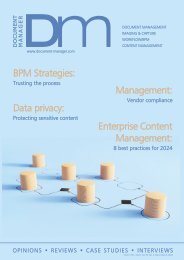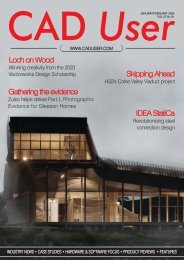Create successful ePaper yourself
Turn your PDF publications into a flip-book with our unique Google optimized e-Paper software.
INDUSTRYfocus<br />
On the right track<br />
Bentley's digital twin technology provides a model for the next generation of the country's rail<br />
infrastructure. Good enough for the next 150 years?<br />
solutions, using simulations to replan and<br />
reoptimise project schedules, and using<br />
digital twins to produce end-to-end<br />
feedback to enhance the decision making<br />
process. Longer term trends will see<br />
greater use of digital tools to increase<br />
productivity and R&D expenditure,<br />
particularly in off-site construction<br />
technologies and building in controlled<br />
environments. Digital twins, Steve added,<br />
will be foremost in accelerating the trend<br />
towards a more economical and<br />
sustainable future.<br />
There was an interesting underscore<br />
to Bentley's recent Virtual Press<br />
Conference when Steve Cockerell,<br />
Industry Marketing Director, Road and<br />
Rail, Bentley Systems, listed the<br />
sustainability of different forms of transport<br />
in his introduction on business drivers for<br />
the rail industry. Urbanisation is a key<br />
feature of the way the civilised world is<br />
developing, he said, rising from a mere<br />
750 million living in cities in 1950 to the<br />
current 4.2 billion people, or 55% of the<br />
world's population. This is expected to rise<br />
to 68% of the world's population by 2050.<br />
Rail and mass transit systems, he<br />
argued, are the only way to keep cities<br />
moving. His argument was strengthened<br />
further when he quoted the carbon<br />
footprints of different forms of transport,<br />
ranging from an aggregated 254g of CO2<br />
emissions per kilometre of domestic<br />
flights to 171g for cars, down to 41g for<br />
domestic rail and a mere 6g for Eurostar.<br />
The drive to eradicate fossil fuels and the<br />
growth of electrification of all forms of<br />
transport will obviously change much of<br />
this, but the radical shifts in the way<br />
people will work and live in the future<br />
could also contribute to the ongoing<br />
demands for effective rail infrastructure.<br />
The Covid-19 pandemic has turned<br />
HS2 goes underground<br />
everything on its head. Now that working<br />
from home is seen as a viable alternative<br />
to the daily commute and crowded offices<br />
the expected urbanisation could well turn<br />
out to be domestic rather than<br />
commercial, with office blocks being<br />
converted into apartments. Higher density<br />
occupation leaves little room for personal<br />
transport, and the economics of owning<br />
an expensive piece of metal which is<br />
either gridlocked or parked outside your<br />
apartment for 99% of the time preclude<br />
private ownership. Public transport, of all<br />
kinds, will become the norm in the city,<br />
with rapid transport systems connecting<br />
each city hub.<br />
Covid-19 should therefore now be seen<br />
as an opportunity, rather than a challenge<br />
according to Steve - and taking<br />
advantage of that opportunity relies on us<br />
working 'smarter', enabled by a growing<br />
demand for 'the digitalising' of the<br />
network. He believes that the industry can<br />
emerge stronger from the pandemic and<br />
that evidence for this has come from<br />
Bentley's customers, who are helping to<br />
accelerate the pace of digital<br />
collaboration.<br />
Besides the growth of WFH and social<br />
platforms for collaboration, there is an<br />
increased demand for 4D and 5D<br />
NEXT STEPS IN DIGITALISATION<br />
We have been going digital for quite some<br />
time, but only now are we really learning<br />
what we can do with the information we<br />
have available, when we can use it, and<br />
ultimately, how decisions are made. We<br />
have moved through 2D and the 3D, 4D<br />
and 5D dimensions of BIM, and now we<br />
are talking about utilising 6D BIM, the<br />
understanding of whole-life cost of assets,<br />
where most money is proportionately<br />
spent, making better decisions upfront in<br />
terms of both cost and sustainability.<br />
That's just part of it though. Steve also<br />
spoke about the next digital<br />
advancements that will leverage digital<br />
twins - immersive visualisation, the use of<br />
reality modelling and machine learning,<br />
analytics and simulation tools like<br />
pedestrian flow and construction<br />
simulation to handle change<br />
synchronisation.<br />
Bentley's iTwin technology provides the<br />
convergence between the engineering<br />
technology - the building specs, drawings,<br />
documents, models, analyses, geotech<br />
and other specs - and the devices that<br />
test and record the physical aspects of<br />
construction, such as IoT feeds, sensors,<br />
drones, cameras, LIDAR and point<br />
clouds. It then adds the information feeds<br />
and reports like asset tags, work orders,<br />
maintenance and inspection records,<br />
16<br />
<strong>Jul</strong>y/<strong>Aug</strong>ust <strong>2020</strong>

















